Introduction
In a recent draft stream, I watched two content creators whom I consider to be supreme ball knowers discuss their strategies for the best plays throughout the draft. I was a bit disappointed after watching the stream, as the whole conversation focused exclusively on Week 17, correlation, stacking, and game stacking. Every decision made was to either complete a stack or open up a later one. In a less than hour stream, “Week 17” was mentioned 41 times, “correlation” 35 times, “team stacking” 12 times, and “bring backs” 5 times (93 total references).
While I am fully on board with the “stack it up” strategy, at times I feel like the industry goes a bit overboard with its application, as seen above. In this post, I aim to visualize some single-game correlations from 2018-2023 to start the discussion on correlation and the strength of certain relationships in fantasy football.
How to interpret the analysis
In this study, we are going to look at the strength of the relationship between two fantasy positions in a single game. To measure the macro-level strength of the relationship, we will use the metric of the correlation coefficient. For those unfamiliar, a correlation coefficient is a statistical measure that quantifies the strength and direction of the relationship between two variables. The measure is a value between -1 and 1, where a positive number represents a positive correlation—if one increases, the other does as well—and a negative number represents a negative correlation—if one increases, the other likely decreases. The strength of the relationship is shown by its closeness to 1, or inversely, the closer to 0 the value, the greater the indication there is no correlation at all.
You will see scatter plots where each point represents a game result for the player relationship being reviewed. The line represents the correlation coefficient; the flatter the line, the closer to zero the coefficient. Additionally, you will see distributions visualized in density plots. The y-axis represents frequency/density, and the x-axis represents fantasy scoring. The highest points in the plot are the most common, and the tails represent the minimum and maximum outcomes.
Scoring for the analysis: Half point per reception.
Relationship 1: Wide Receiver -> Wide Receiver.
If you were to have the WR1 in the game, is it a better bet to get the opposing WR1 or that team’s WR2?
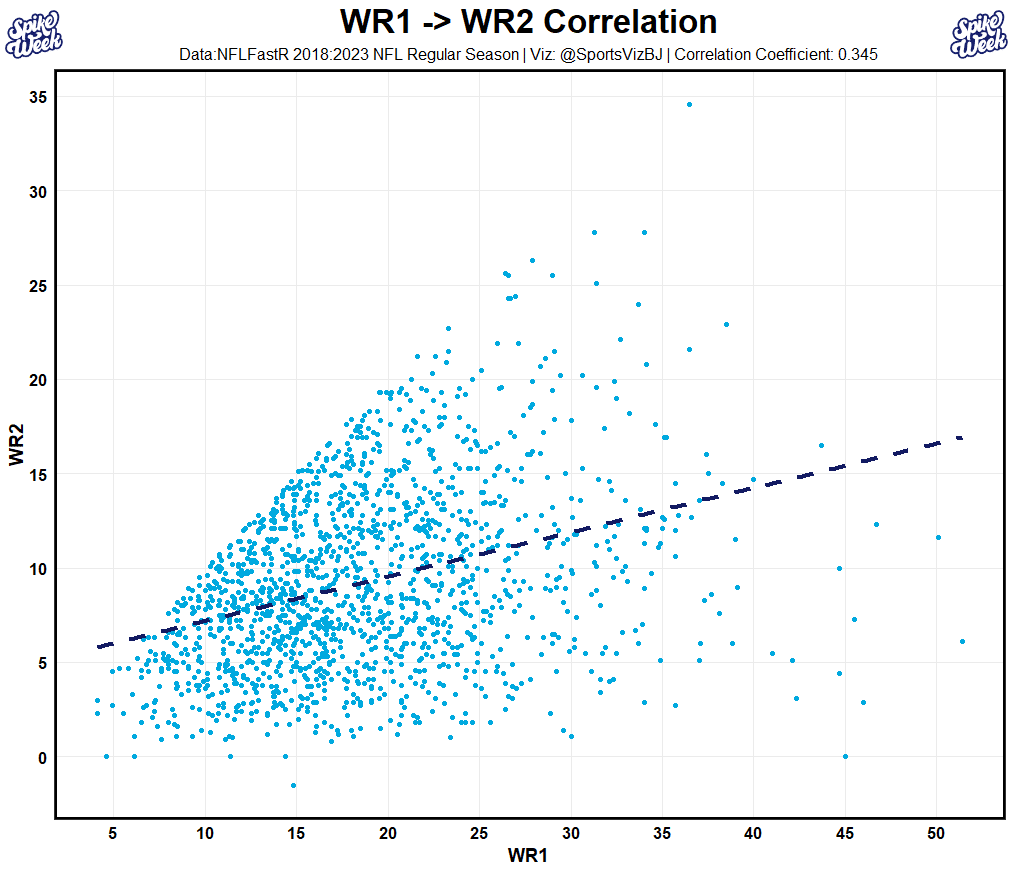
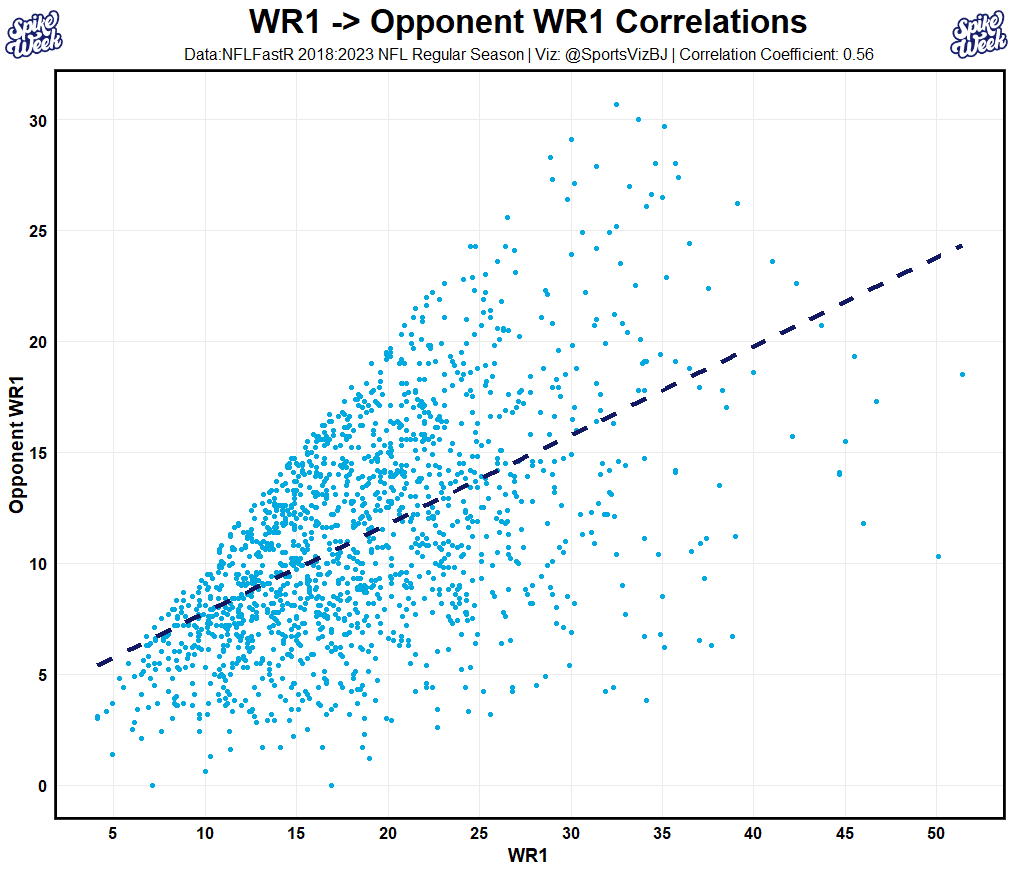
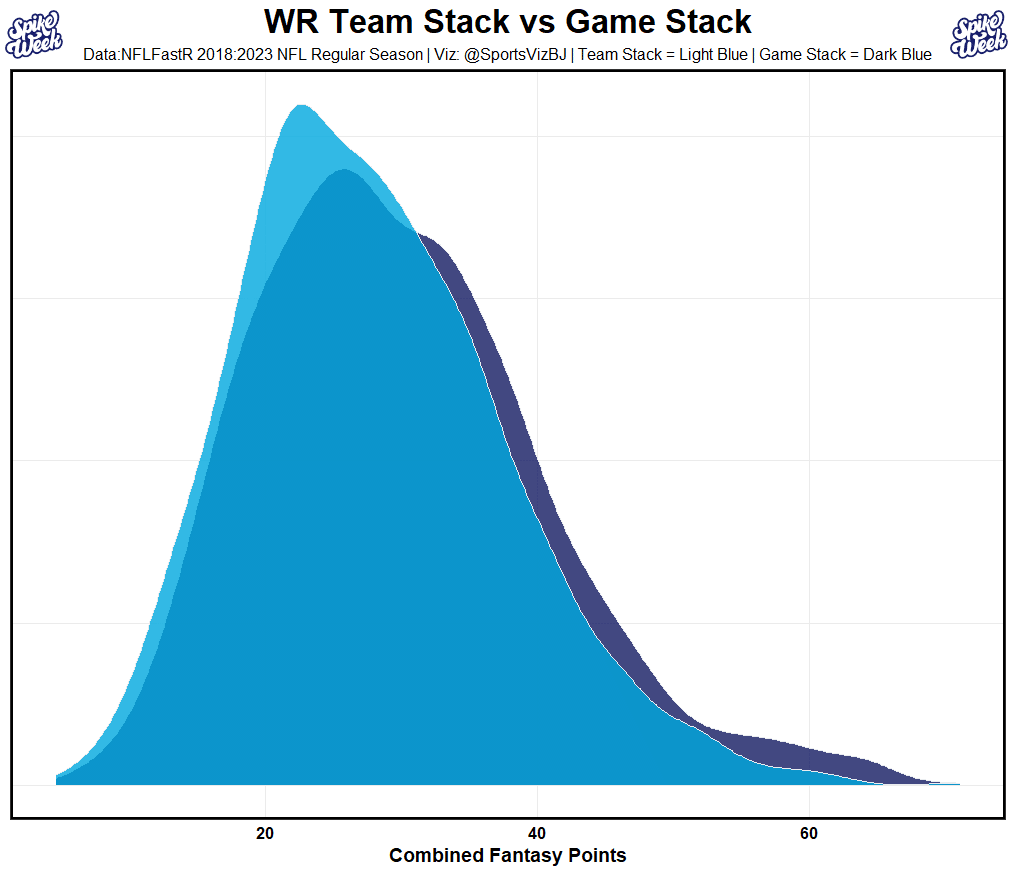
From 2018 to 2023, when having the overall WR1 in a game, the correlation coefficient for the WR1 and the WR2 on the same team (“team stack”) was 0.345. In contrast, the correlation coefficient for the WR1 and the opposing WR1 (“game stack”) was 0.56. Additionally, the distribution of combined points for the game stack was shifted to the right of the team stack. On a single-game basis, the game stack shows a stronger relationship to one another and a higher likelihood of scoring more points than the team stack.
Relationship 2: Wide Receiver -> Running Back.
If you were to have the WR1 in the game, is it a better bet to get the opposing RB1 or that team’s RB1?

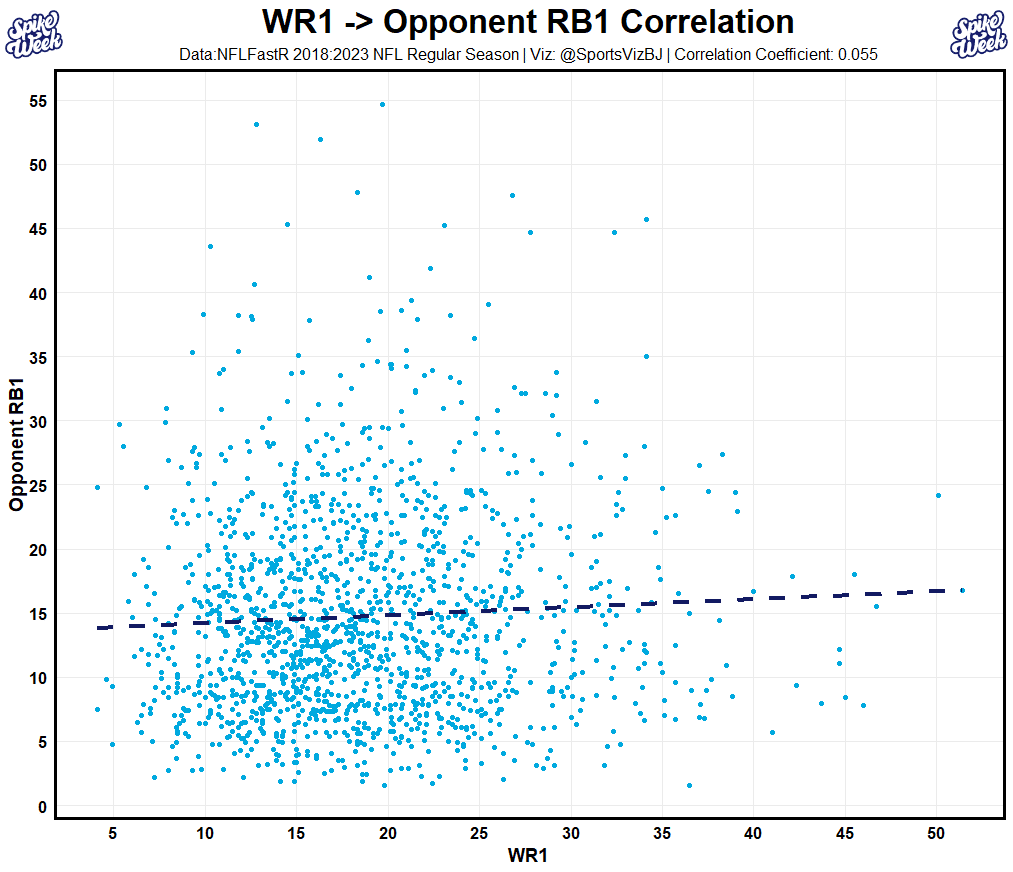

From 2018 to 2023, when having the overall WR1 in a game, the correlation coefficient for the WR1 and the RB1 on the same team (“team stack”) was 0.002. Meanwhile, the correlation coefficient for the WR1 and the opposing RB1 (“game stack”) was 0.055. The distribution of combined points for the game stack was almost identical to the team stack. On a single-game basis, both the game stack and team stack show minimal correlation, with coefficients close to zero and the range of outcomes for both stacks overlapped significantly.
Relationship 3: Wide Receiver -> Tight End.
If you were to have the WR1 in the game, is it a better bet to get the opposing TE1 or that team’s TE1?
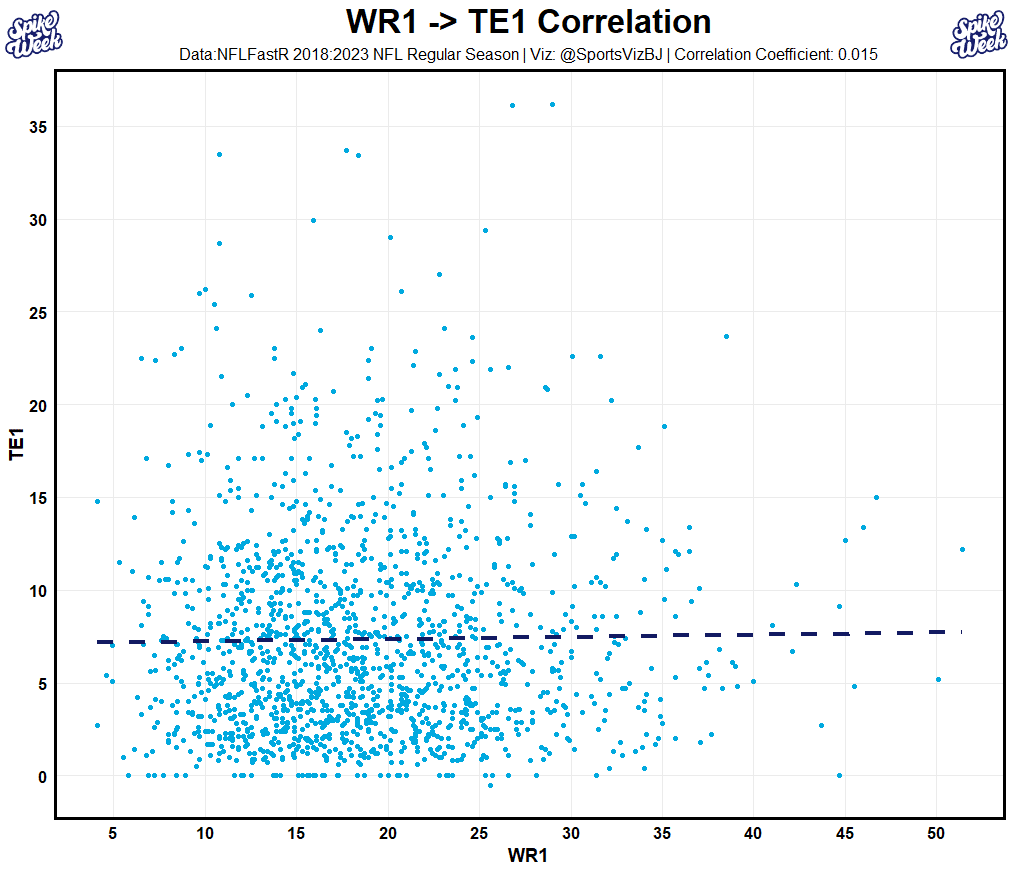
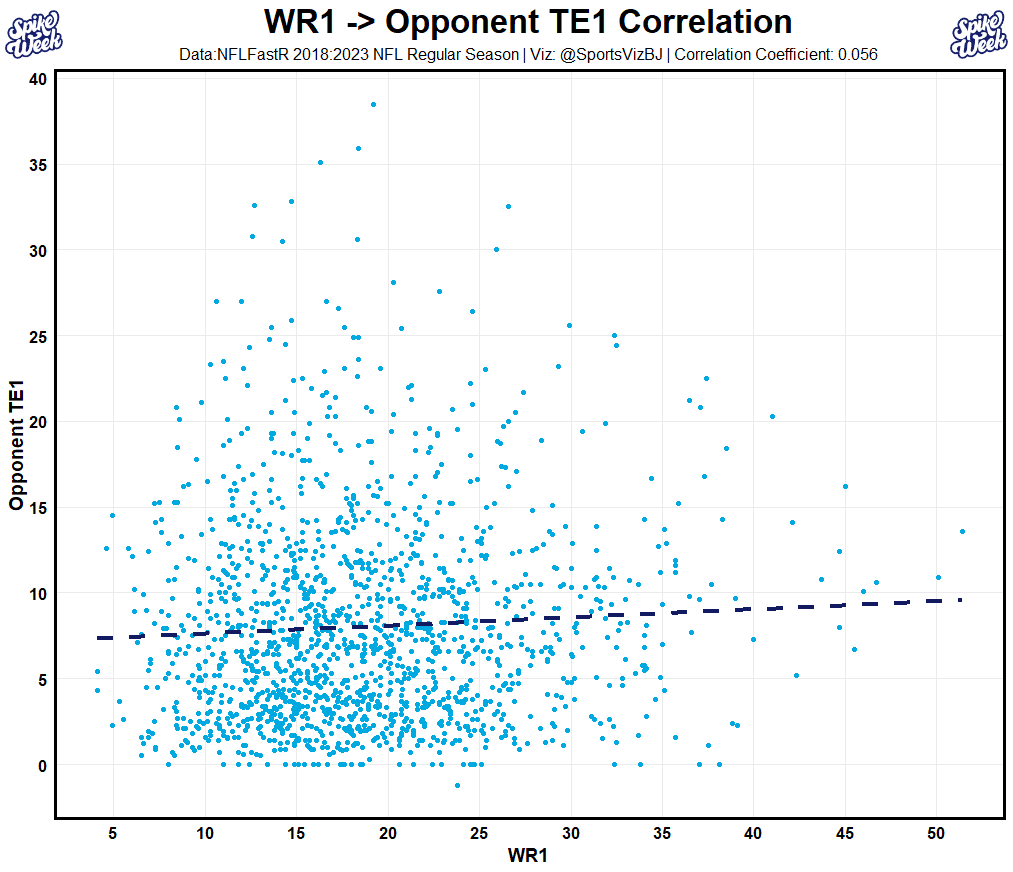
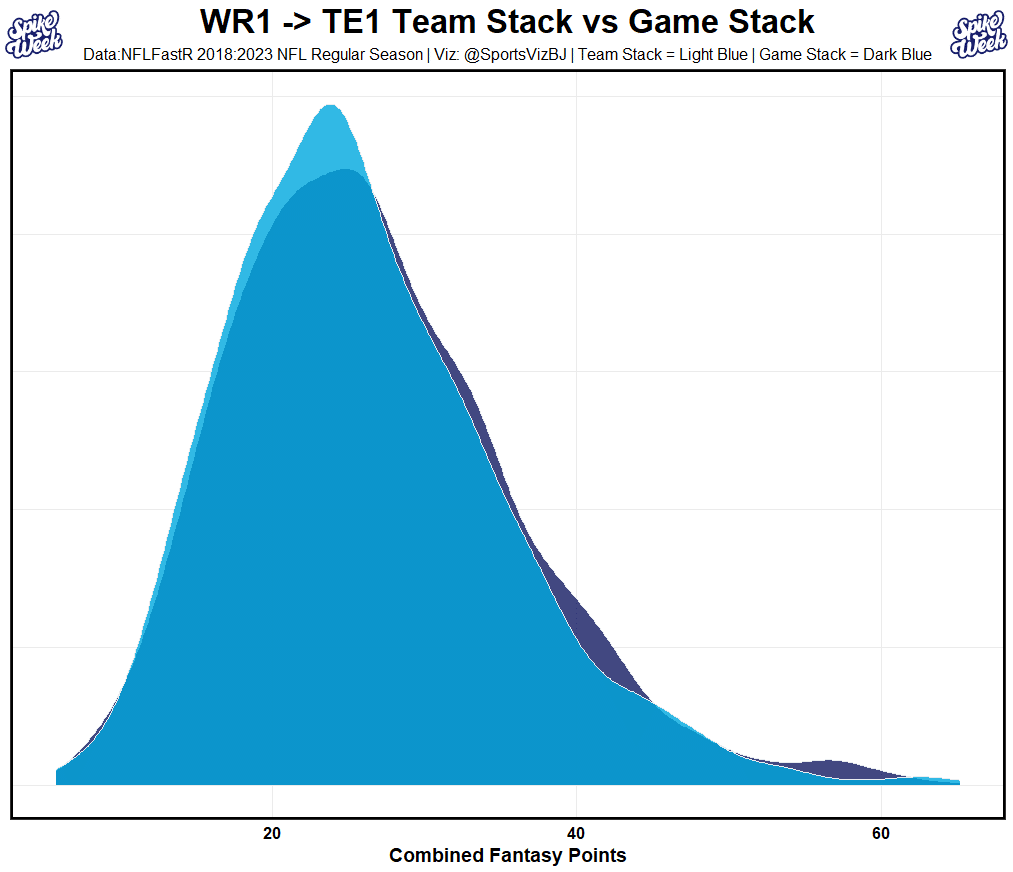
From 2018 to 2023, when having the overall WR1 in a game, the correlation coefficient for the WR1 and the TE1 on the same team (“team stack”) was 0.015. For the WR1 and the opposing TE1 (“game stack”), the correlation coefficient was 0.056. The distribution of combined points for the game stack was almost identical to the team stack. On a single-game basis, both the game stack and team stack show minimal correlation, with coefficients close to zero and the range of outcomes for both stacks overlapped significantly.
Relationship 4: Quarterback -> Teammate.
How strongly are Quarterbacks correlated to their teammates?
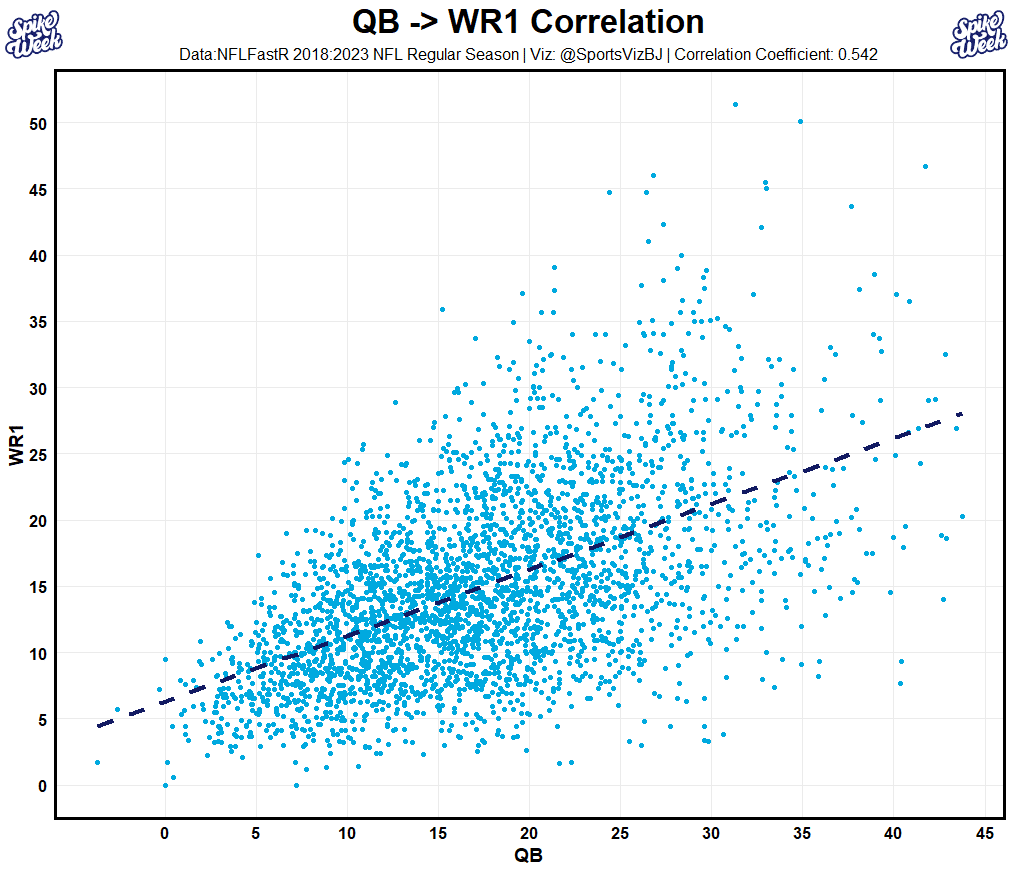
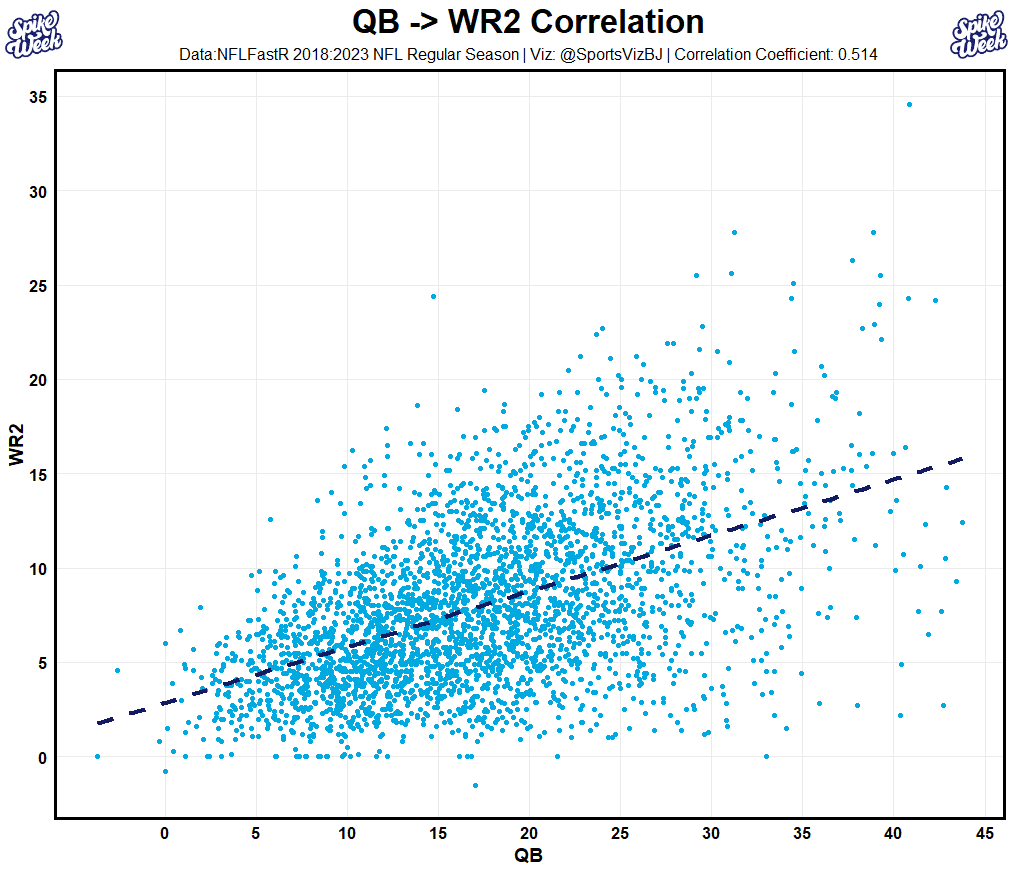
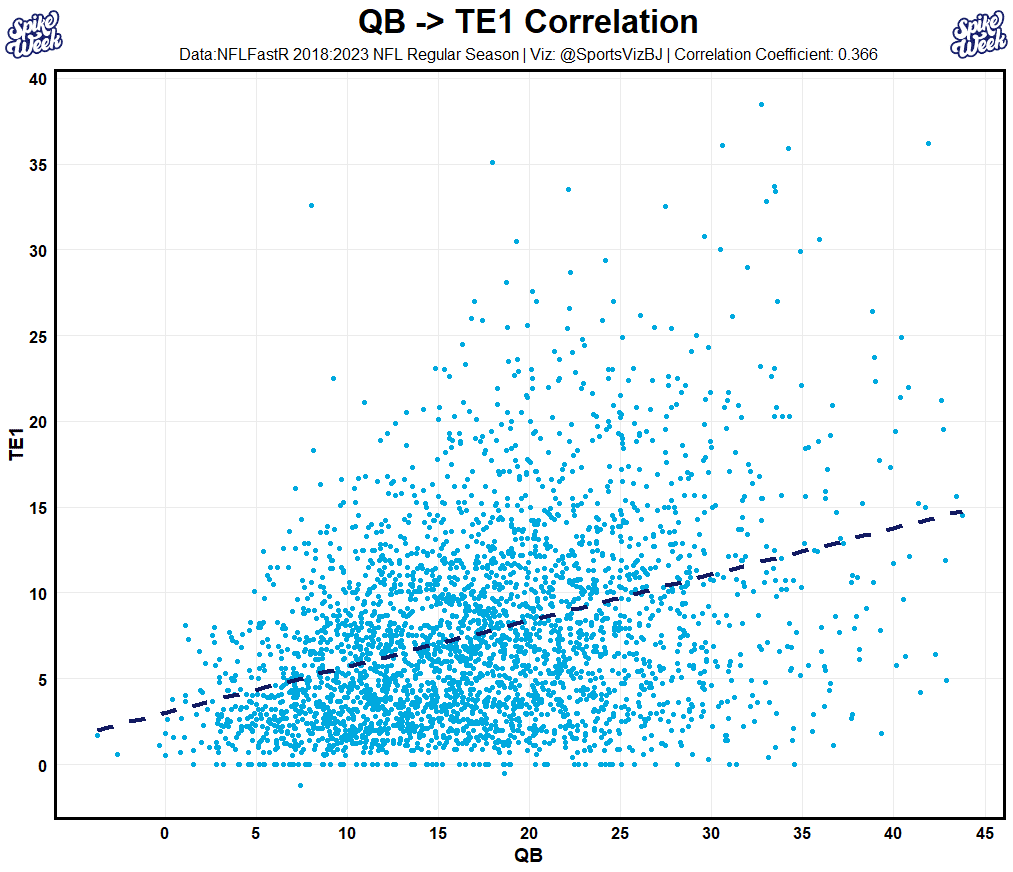
The strength of the relationship between the quarterback and their wide receivers was quite strong, with a correlation coefficient of 0.542 and 0.514 for the WR1 and WR2, respectively. The strength of the relationship between the quarterback and their top tight end decreased in strength compared to that of wide receivers, with a correlation coefficient of 0.366, but was still quite strong.
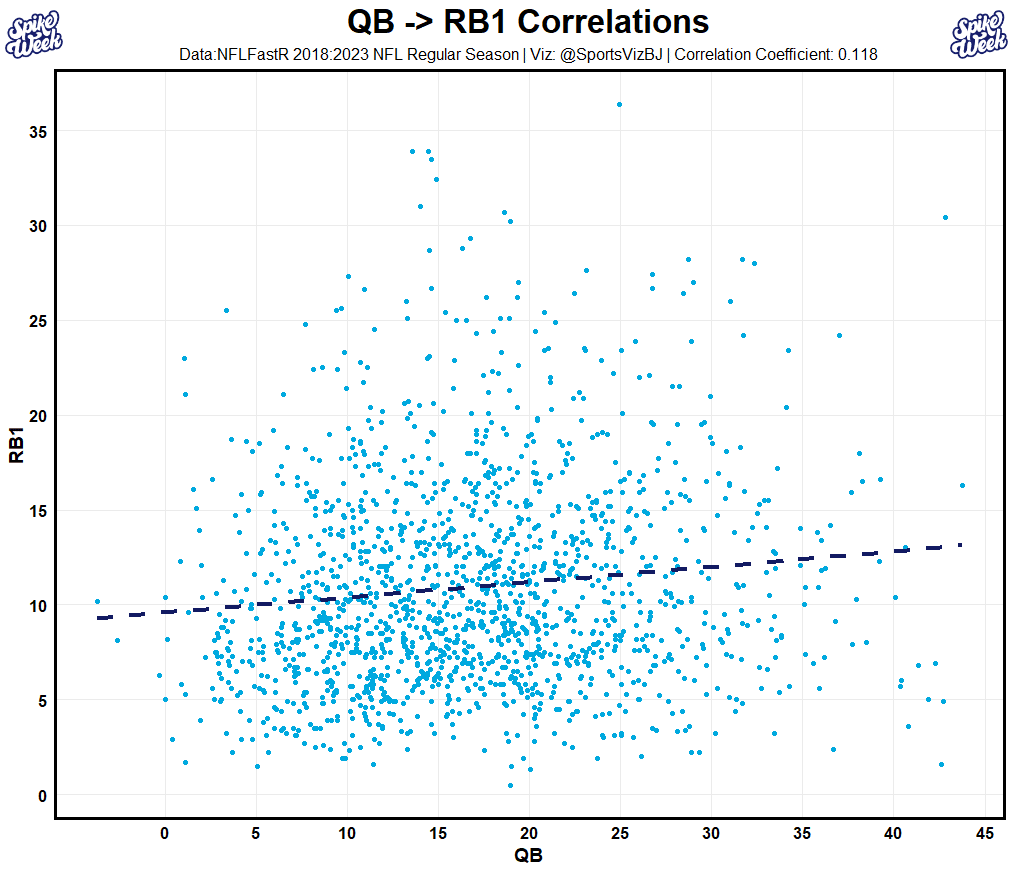
The strength of the relationship between the quarterback and their top running back is almost zero, with a correlation coefficient of 0.09. I then broke down RB performance into two groups: those that were run-heavy vs. receiving-heavy in terms of fantasy scoring.
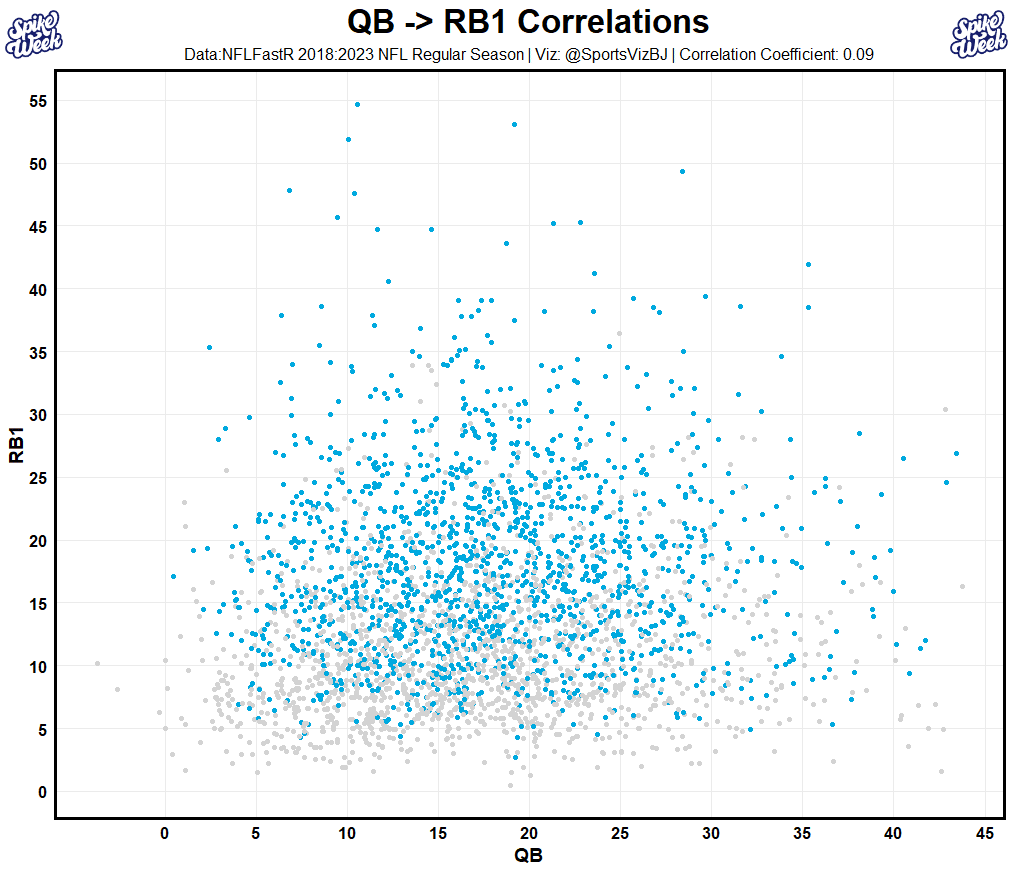
The running back performances that were heavily run-centric (defined as greater than league average fantasy points split) were even less correlated to their QB performance as this population had a correlation coefficient of 0.034.
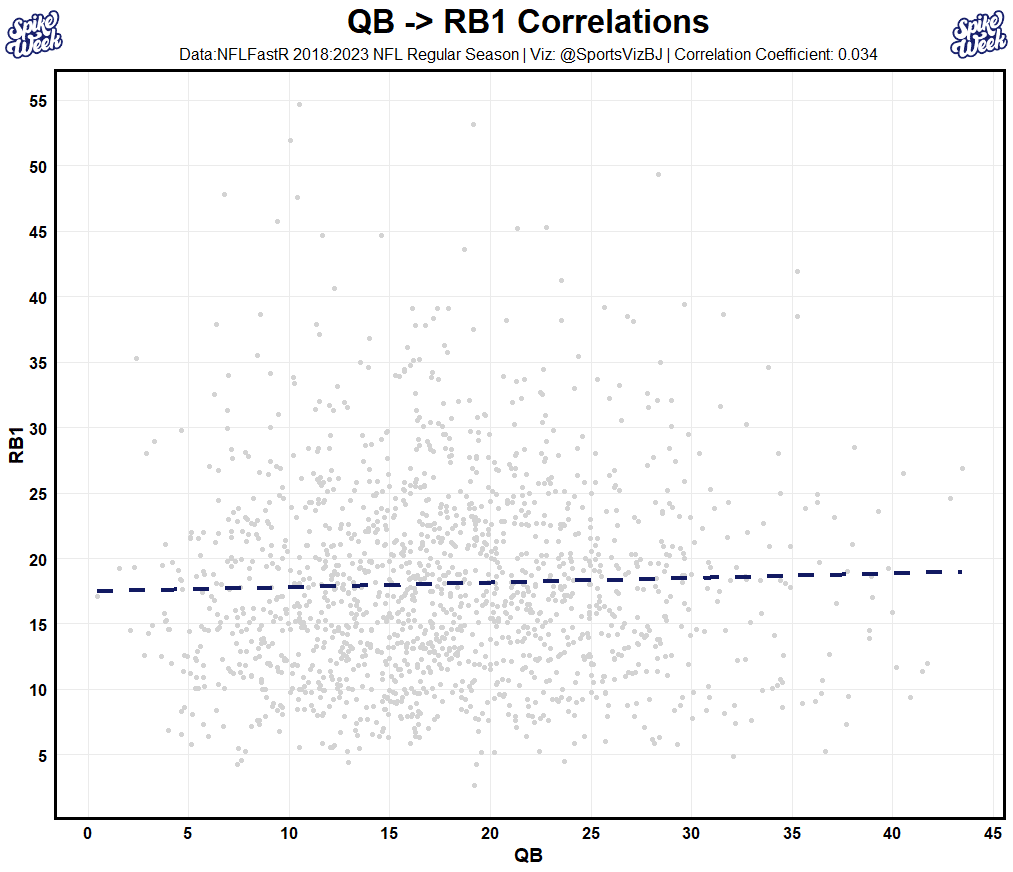
The running back performances that were more heavily skewed to receiving-centric scoring were much more correlated to quarterback scoring as this population had a correlation coefficient of 0.118, almost 3.5x as strong of a relationship.

Caveats and Takeaways
- Single game vs. season long: These correlations reflect single-game correlation, not season-long correlation. For season-long performance, we would see a much stronger relationship between a quarterback and running back on the same team.
- Stacking pass catchers (WRs & TEs) is generally very effective: The correlation coefficients suggest a strong relationship between quarterbacks and wide receivers/tight end scoring compared to running backs. Some of my favorite passing offenses to stack are:
- Cowboys & Bengals: Very insightful Billy to say it’s smart to stack two of the top wide receivers in the game with their quarterbacks (sarcasm). But with both Prescott and Burrow, there is very often the opportunity to take advantage of massive ADP values when draft rooms don’t want to buy into these non-rushing quarterbacks without their receivers. We should even be able to manufacture this to happen by owning pass catchers in these consolidated offenses (Chase & Higgins or Lamb & Ferguson), then letting their QBs often fall into our lap after ADP.
- Game Stack vs. Team Stack of WRs: Game stack is much higher correlated, as well as the distribution is shifted to the right of a team stack. My favorite week 17 game to stack at the moment is:
- Colts x Nabers: The Colts Quarterback Anthony Richardson is a popular pick to be the breakout QB1 this year. Malik Nabers on the opposite side of the matchup should be hitting his stride late in the season as well, as the Colts were a fruitful fantasy matchup to attack in 2023. While you may be giving up some season-long projected points targeting the receivers in this game, for single-game upside, this is as good as any.
- Also check out this thread I did visualizing game and passing stacks for week 15, 16, and 17.
- RB stacking boost is extremely weak: The correlation between QB/WR/TE and RB1, whether on the same team or opposing teams, is very weak. When looking to stack running backs, the profile of the player is important to consider as some running backs are linked to the passing game, or better said, those who are not. These are the RBs I am quite comfortable leaving unstacked:
- Filter: Using FantasyPros aggregated projections of ESPN and CBS, I found 15 running backs that had 75% or greater of their projected points coming from rushing production (rushing yards + rushing TDs – fumbles lost) with a total projected season-long fantasy points of 75 points or higher.
- Kyren Williams, Jonathan Taylor, Derrick Henry, Josh Jacobs, Kenneth Walker, Raheem Mostert, David Montgomery, Zamir White, Nick Chubb, Najee Harris, Gus Edwards, Ty Chandler, Trey Benson, Blake Corum, and D’Onta Foreman.
Conclusion
By visualizing these correlations, I hope you now better understand the relationships between different positions in fantasy football. While stacking remains a key component of my strategy, it’s important not to overweight the boost we are getting from certain relationships. Be on the lookout for a season long spin on this analysis.




